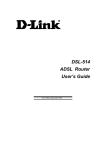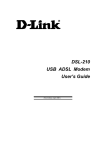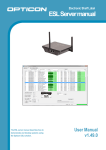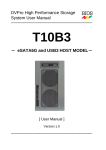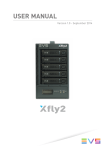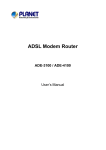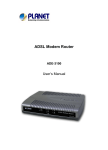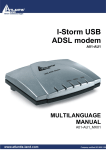Download D-Link DSL-310 User`s guide
Transcript
DSL-310 ADSL Modem User’s Guide DSL-310 ADSL Modem User’s Guide (First Edition May 2003) i DSL-310 ADSL Modem User’s Guide FCC Warning This equipment has been tested and found to comply with the limits for a Class B digital device, pursuant to part 15 of the FCC Rules. These limits are designed to provide reasonable protection against harmful interference in a residential installation. This equipment generates, uses and can radiate radio frequency energy and, if not installed and used in accordance with the instructions, may cause harmful interference to radio communications. However, there is no guarantee that interference will not occur in a particular installation. If this equipment does cause harmful interference to radio or television reception, which can be determined by turning the equipment off and on, the user is encouraged to try to correct the interference by one or more of the following measures: -Reorient or relocate the receiving antenna. -Increase the separation between the equipment and receiver. -Connect the equipment into an outlet on a circuit different from that to which the receiver is connected. -Consult the dealer or an experienced radio/ TV technician for help. CE Mark Warning This is a Class B product. In a domestic environment, this product may cause radio interference, in which case the user may be required to take adequate measures. Warnung! Dies ist in Produkt der Klasse B. Im Wohnbereich kann dieses Produkt Funkstoerungen verursachen. In diesem Fall kann vom Benutzer verlangt werden, angemessene Massnahmen zu ergreifen. Advertencia de Marca de la CE Este es un producto de Clase B. En un entorno doméstico, puede causar interferencias de radio, en cuyo case, puede requerirse al usuario para que adopte las medidas adecuadas. Attention! Ceci est un produit de classe B. Dans un environnement domestique, ce produit pourrait causer des interférences radio, auquel cas l`utilisateur devrait prendre les mesures adéquates. Attenzione! Il presente prodotto appartiene alla classe B. Se utilizzato in ambiente domestico il prodotto può causare interferenze radio, nel cui caso è possibile che l`utente debba assumere provvedimenti adeguati. i DSL-310 ADSL Modem User’s Guide TABLE OF CONTENTS About This User’s Guide ..........................................................................................V Guide Overview ..............................................................................................................................................v Before You Start .......................................................................................................VI Installation Overview .................................................................................................................................... vi Requirements ................................................................................................................................................ vi Low Pass Filters ........................................................................................................................................... vi Operating System ......................................................................................................................................... vi Web Browser ................................................................................................................................................. vi Ethernet Port (NIC Adapter) ....................................................................................................................... vii Additional Software ..................................................................................................................................... vii Account Information (User Name and Password) ....................................................................................... vii Additional PVC Settings .............................................................................................................................. vii Unpacking ....................................................................................................................................................viii Chapter 1 - Introduction ..........................................................................................1 What is ADSL? ...............................................................................................................................................1 Modem Description and Operation .................................................................................................................1 Product Features .............................................................................................................................................2 Front Panel ......................................................................................................................................................2 Rear Panel .......................................................................................................................................................3 Chapter 2 – Hardware Installation .........................................................................4 Connect the ADSL .........................................................................................................................................4 Computer to Modem Connection ...................................................................................................................4 Computer Ethernet LAN to Modem ...............................................................................................................5 Hub or Switch to Modem Connection ............................................................................................................5 Power On Modem ...........................................................................................................................................5 Chapter 3 – First Time Set Up .................................................................................6 IP Settings .......................................................................................................................................................6 Configuring IP Settings ...................................................................................................................................6 Windows XP ............................................................................................................................................7 Windows 2000 .........................................................................................................................................10 Windows ME ........................................................................................................................................13 ii DSL-310 ADSL Modem User’s Guide Windows 98SE ....................................................................................................................................17 Access the Web Configuration ......................................................................................................................21 Using the Configuration Wizard ...................................................................................................................22 Chapter 4 – Connecting to the Internet..................................................................26 Connect with Bridge Mode ...........................................................................................................................26 Configuring IP Setting On Windows XP ...............................................................................................27 Configuring IP Setting On Windows 2000 ............................................................................................30 Configuring IP Setting On Windows ME ..............................................................................................33 Configuring IP Setting On Windows 98SE ............................................................................................38 Connect with PPP Mode ...............................................................................................................................43 Chapter 5 – Web-based Configuration ..................................................................44 Home ............................................................................................................................................................ 44 Wizard ................................................................................................................................................... 44 WAN ...................................................................................................................................................... 45 LAN ....................................................................................................................................................... 46 Advanced ...................................................................................................................................................... 46 ADSL ..................................................................................................................................................... 46 SNMP .................................................................................................................................................... 47 Tools ............................................................................................................................................................. 47 Admin .................................................................................................................................................... 47 Time ....................................................................................................................................................... 48 System ................................................................................................................................................... 48 Firmware ................................................................................................................................................ 49 Misc. ...................................................................................................................................................... 51 TEST ..................................................................................................................................................... 51 Status ............................................................................................................................................................ 52 Device Info ............................................................................................................................................ 52 Log ......................................................................................................................................................... 52 Traffic .................................................................................................................................................... 53 ATM ...................................................................................................................................................... 54 TCP ....................................................................................................................................................... 55 ADSL .................................................................................................................................................... 56 iii DSL-310 ADSL Modem User’s Guide Appendix A - Technical Specifications ..................................................................57 Appendix B – Microfilters and Splitters ...............................................................58 In-Line Filters ................................................................................................................................................58 Line Splitter ...................................................................................................................................................59 iv DSL-310 ADSL Modem User’s Guide About This User’s Guide This user’s guide provides instructions on how to install the DSL-310 ADSL Modem and use it to connect a computer or Ethernet LAN to the Internet. If you are using a computer with a functioning Ethernet port, you can use the Quick Installation Guide to quickly establish your ADSL connection and access the Internet. ADSL services are provided by, and sold by a variety of businesses. Your ADSL service provider may be your telephone company, an Internet service provider (ISP), a business that specializes in providing network services or a combination of any of these. This guide uses the generic terms DSL service provider and network service provider, to refer to any business or agent that provides DSL service. Guide Overview Chapter 1 – Introduction describes the Modem and its key features. Provides an introduction to ADSL. Lists standards to which the Modem complies. Contains a packing list. Chapter 2 – Hardware Installation discusses how to connect the Modem to an Ethernet LAN. Chapter 3 – First Time Set Up provides information on how to configure the Modem and establish the ADSL connection using the Web-based manager. Chapter 4 – Provides information on how to configure the Modem and establish the ADSL connection. Chapter 5 – Web based Configuration describes how to use the web-based manager to change Modem settings and configure additional virtual connections (PVCs). Appendix A - Technical Specifications is a list the technical specifications of the Modem, including standards compliance. Appendix B – Microfilters and Splitters describes the contains illustrated examples of how to use low pass filters. v DSL-310 ADSL Modem User’s Guide Before You Start Please read and make sure you understand all the prerequisites for proper installation of your new Modem. Have all the necessary information and equipment on hand before beginning the installation. Installation Overview The procedure to install the Modem can be described in general terms in the following steps: 1. Gather information and equipment needed to install the device. Before you begin the actual installation make sure you have all the necessary information and equipment. 2. Install the hardware, that is, connect the cables (Ethernet and telephone) to the device and connect the power adapter. 3. Check the IP settings on your computer and change them if necessary so the computer can access the web-based software built into the Modem. 4. Use the web-based management software to configure the device to suit the requirements of your ADSL account. Requirements To install and use the Modem you need a computer equipped with an Ethernet port (such as an Ethernet NIC) and a web browser. You may also need to use information given to you by your ISP or ADSL service provider. This information is stored in the Modem’s memory and used to establish the ADSL connection and confirm your identity. Read the next page for more details about these requirements. Low Pass Filters Since ADSL and telephone services share the same copper wiring to carry their respective signals, a filtering mechanism may be necessary to avoid mutual interference. A low pass filter device can be installed for each telephone that shares the line with the ADSL line. These filters are easy to install passive devices that connect to the ADSL device and/or telephone using standard telephone cable. Ask your service provider for more information about the use of low pass filters with your installation. Appendix B provides illustrated examples of how to install two common styles of low pass filters. Operating System The DSL-310 uses an HTML-based web interface for setup and management. The web configuration manager may be accessed using any operating system capable of running web browser software. Web Browser Any common web browser can be used to configure the Modem using the web configuration management software. The program is designed to work best with more recently released browsers such as Microsoft Internet Explorer® version 5.0, Netscape Navigator® version 4.7, or later versions. The web browser must have JavaScript enabled. JavaScript is enabled by default on many browsers. Make sure JavaScript has not been disabled by other software (such as virus protection or web user security packages) that may be running on your computer. vi DSL-310 ADSL Modem User’s Guide Ethernet Port (NIC Adapter) Any computer that uses the Modem must be able to connect to it through the Ethernet port on the Modem. This connection is an Ethernet connection and therefore requires that your computer be equipped with an Ethernet port as well. Most notebook computers are now sold with an Ethernet port already installed. Likewise, most fully assembled desktop computers come with an Ethernet NIC adapter as standard equipment. If your computer does not have an Ethernet port, you must install an Ethernet NIC adapter before you can use the Modem. If you must install an adapter, follow the installation instructions that come with the Ethernet NIC adapter. Additional Software It may be necessary to install software on your computer that enables the computer to access the Internet (through computers operated by your ISP or service provider). Additional software must be installed if you are using what is called a PPP (Point to Point Protocol) connection. For a PPP (Point to Point Protocol) connection, the information needed to make and maintain the Internet connection is stored on your computer, not in the Modem. This type of connection is similar to the arrangement used for analog dial-up modems, but the connection speed is much faster. Various terms are to describe a bridged ADSL connection including the term “RFC 1483 Bridge” which is used in this guide. If your ADSL service is delivered through a “bridged” connection, the information needed to establish and maintain the Internet connection is stored in the Modem. In this case, it is not necessary to install software on your computer. Account Information (User Name and Password) Most users will need to supply a user name and password used to access the service provider’s network (and ultimately, the Internet). This information is stored either in the Modem’s memory or on your computer depending on the type of ADSL connection you have. ACCOUNT INFORMATION (PPP Connections Only) User Name: Password: Additional PVC Settings If you are using multiple virtual connections it will be necessary to provide additional VPI and VCI values for the device. These numbers define a unique route used on the ATM backbone of the WAN. vii DSL-310 ADSL Modem User’s Guide Unpacking Open the shipping carton and carefully remove all items. In addition to this User's Guide, ascertain that you have: 1. One DSL-310 ADSL Modem 2. One CD-ROM with this User’s Guide and the Quick Installation Guide 3. One twisted-pair telephone cable used for ADSL connection 4. One CAT-5 Ethernet cable. 5. One AC power adapter suitable for your electric service. 6. One Quick Installation Guide hardcopy. viii DSL-310 ADSL Modem User’s Guide Chapter 1 - Introduction ADSL modem technology is a relatively new technology and may be unfamiliar to the reader. In this section, we introduce you to ADSL technology and give a brief description of its key attributes. We also give a general description of the D-Link DSL-310 ADSL Modem and its main features. What is ADSL? Asymmetric Digital Subscriber Line (ADSL) is an access technology that utilizes ordinary copper telephone lines to enable broadband high-speed digital data transmission and interactive multimedia applications for business and residential customers. Using existing phone lines avoids the need for adding expensive new cable. ADSL modems use digital coding techniques that greatly increase the bandwidth capacity of telephone lines without interfering with regular telephone services. For the ADSL modem user, this means much faster data communications. ADSL modems make it possible to enjoy benefits such as high-speed Internet access, telecommuting, collaborative computing, distance learning, movies on demand and multi-player video gaming without experiencing any loss of quality or disruption of voice/fax telephone capabilities. ADSL provides a dedicated service over a single telephone line operating at speeds of up to 8 Mbps downstream (to the user) and up to 640 Kbps upstream, depending on the type of service and local telephone line conditions. These conditions are ideal for many user applications. A secure point-topoint connection is established between the user and the central office of the local telephone company. The user is always connected, thus eliminating dial-up time and simplifying connectivity issues. D-Link ADSL devices incorporate the recommendations of the ADSL Forum (www.adsl.com) regarding framing, data format, and upper layer protocols. Modem Description and Operation The DSL-310 ADSL Modem is designed to provide a simple, cost-effective and secure ADSL Internet connection for your small to medium-sized private network. The ADSL connection technology enables many interactive multi-media applications such as video conferencing and collaborative computing. The Modem is easy to install and use. The DSL-310 connects to an Ethernet LAN or single computer via a standard Ethernet interface. The ADSL connection is made using ordinary twisted-pair telephone line with standard RJ-11 connectors. Software drivers for D-Link ADSL Modems can be fully upgraded by simply loading newer versions onto your PC. This will allow you to update the modem and use new features and enhancements as they are developed and standardized. Online information regarding the latest downloadable software and improvements can be found at D-Link Technical support website of your country. DSL-310 ADSL Modem User’s Guide Product Features The D-Link DSL-310 ADSL Modem provides the following features: • Data rates up to 8 Mbps for downstream and 1M bps for upstream • Friendly web-based graphical user interface for configuration and management • Supports up to eight simultaneous virtual connections for a single ADSL account • Supports T1.413 issue 2, G.dmt and G.lite standards • Auto-handshake and rate adaptation for different ADSL flavors • Widest range of DSLAM interoperability • Bridge IP over ATM LLCSNAP (RFC 1483) • Built-in MIBs for SNMP management • Upgradeable firmware through HTTP Front Panel Place the Modem in a location where the LED indicators can be easily viewed. The LED Indicators read as follows: Power Steady green light indicates the unit is powered on. Status Blinking green indicates normal operation. Ethernet: Link/ Act Steady green light indicates a valid Ethernet connection. Blinking green indicates an active Ethernet session. ADSL: Link/Act Steady green light indicates a valid ADSL connection. This will light after the ADSL negotiation process has been settled. Blinking green light indicates an active WAN session. DSL-310 ADSL Modem User’s Guide Rear Panel All cable connections to the Modem are made at the rear panel. The factory-reset button is located here as well. ADSL port Ethernet port Connect ADSL Connect Ethernet cable here cable here Factory Reset button Power cord Connect here DSL-310 ADSL Modem User’s Guide Chapter 2 - Hardware Installation In this chapter you will learn about the various connections you will need to make in order to use the Modem. When selecting the location for the Modem, allow ample room to access the connections on the rear panel. For convenience, try to place the Modem near your computer so you can monitor the LED indicators. Allow some space above the Modem for ventilation to avoid problems with overheating. Connect the ADSL Line Use the twisted-pair ADSL cable (standard telephone cable) included with the Modem to connect it to your telephone line. Simply plug one end of the cable into the ADSL port (RJ-11 receptacle) on the rear panel of the Modem and insert the other end into the wall jack. Computer to Modem Connection You can begin installing the Modem by performing the following steps: 1. Insert the Installation CD into the CD-ROM drive. 2. Insert one end of the ADSL cable (26 AWG twisted-pair telephone cable) into the telephone wall jack (RJ-11 port). 3. Insert the other end of the ADSL cable into the ADSL port (RJ-11 port) on the Modem. 4. Follow the software installation instructions in Chapter 3. You can connect the Modem directly to a 10/100BASE-TX Ethernet adapter card (NIC) installed on a PC using the Ethernet cable provided as shown in this diagram. DSL-310 DSL-310 ADSL Modem User’s Guide Connect Ethernet LAN to Modem The Modem may be connected to any 10/100BASE-TX Ethernet LAN. Any connection to an Ethernet concentrating device such as a switch or hub must operate at a speed of 10/100 Mbps only. When connecting the Modem to any Ethernet device that is capable of operating at speeds higher than 10Mbps, be sure that the device has auto-negotiation (NWay) enabled for the connecting port. Use standard twisted-pair cable with RJ-45 connectors. The RJ-45 port on the Modem is a crossed port (MDI-X). Follow standard Ethernet guidelines when deciding what type of cable to use to make this connection. When connecting the Modem directly to a PC or server use a normal straight-through cable. You should use a crossed cable when connecting the Modem to a normal (MDI-X) port on a switch or hub. Use a normal straight-through cable when connecting it to an uplink (MDI-II) port on a hub or switch. The Ethernet Link LED indicator will indicate a valid connection. The rules governing Ethernet cable lengths apply to the LAN to Modem connection. Be sure that the cable connecting the LAN to the Modem does not exceed 100 meters. Hub or Switch to Modem Connection Connect the Modem to an uplink port (MDI-II) on an Ethernet hub or switch with a straight-through cable as shown in the diagram below: If you wish to reserve the uplink port on the switch or hub for another device, connect to any on the other MDI-X ports (1x, 2x, etc.) with a cross-wired cable or use crossover adapter. DSL-310 Power On Modem To power on the device: 1. Insert the AC Power Adapter cord into the power receptacle located on the back of the Modem and plug the adapter into a nearby power source. 2. You should see the Power LED indicator light up and remain lit. DSL-310 ADSL Modem User’s Guide Chapter 3 - First Time Set Up Now that the Modem is powered on and connected to your computer you are ready to proceed to the next step. However, before going further, make certain you have a valid link to the Modem. You can check this by looking at the Ethernet Link LED indicator on the front panel of the Modem. If the LED is green you have a link, if it is dark, check both ends of the cable to make sure it is firmly connected to the Modem and your computer’s Ethernet port. A valid Ethernet link means that your computer is physically linked to the Modem, however, you will not to able to access the web-based configuration manager until the computer can “see” the device. In order to see the Modem both your computer and the Modem must be in the same IP “neighborhood” or subnet on your local area network (LAN). You will need to check the IP settings of your system and, if necessary, change them so the computer and Modem are in the same subnet. Follow the instructions in this chapter to configure the IP settings of your system. For some Modem users, it will not be necessary to change any settings on the Modem for the device to work properly. If you received a CD with software for your computer, the Modem may be ready to use. Follow the instructions of your service provider regarding any connection software for your computer. The first time you set up the Modem it is best to first establish the ADSL connection using one non-networked computer. This way you can verify that the ADSL service is functioning and that you are able to communicate with the device. Once the initial ADSL connection is established, you can connect the device to the Ethernet LAN. IP Settings To access the Modem’s management software that uses a web-based (HTML) interface for configuration, you will probably have to change the LAN IP settings of your computer. The LAN IP settings are what your browser uses to find and communicate with the Modem. The Modem has a default IP address of 192.168.0.2 and a subnet mask of 255.255.255.0 these numbers are the LAN IP settings of the Modem. You will need to change the IP settings on your computer so the IP address is 192.168.0.10 and the subnet mask is 255.255.255.0. If you do not know how to change IP settings for your operating system, read the following section or consult the Help directory or the user’s guide included with your system. Configuring IP Settings Follow these instructions to configure the IP settings for the operating system installed on your computer. Note If you are using this Modem to provide Internet access for more than one computer, you can use these instructions later to change the IP settings for the other computers. However you cannot use the same IP address since every computer must have its own IP address that is unique on the local network. DSL-310 ADSL Modem User’s Guide Windows XP for TCP/IP 1. In the Windows task bar, click the Start button, point to Settings, and then click Control Panel. 2. Double-click the Network Connections icon. DSL-310 ADSL Modem User’s Guide 3. In the LAN or High-Speed Internet window, right-click on icon corresponding to your network interface card (NIC) and select Properties. (This icon may be labeled Local Area Connection) 4. In the General tab of the Local Area Connection Properties menu. Highlight Internet Protocol (TCP/IP) under “This connection uses the following items.” by click on it once. Click on the Properties button. DSL-310 ADSL Modem User’s Guide 5. Select Use the following IP address: by clicking once in the circle. Type in IP settings as follows, IP address: 192.168.0.10, Subnet mask: 255.255.255.0 and Default gateway: 192.168.0.2. The IP address information for the enter DSL-310 Web Page. Click OK button to confirm and save your changes, and then close the Control Panel. 6. The Local Area Connection Properties window appears. Click OK button to end this procedure. DSL-310 ADSL Modem User’s Guide Windows 2000 for TCP/IP 1. In the Windows task bar, click the Start button, point to Settings, and then click Control Panel. 2. Double-click the Network and Dial-up Connections icon. DSL-310 ADSL Modem User’s Guide 3. In the Network and Dial-up Connections window, right-click the Local Area Connection icon, and then select Properties. 4. In the Local Area Connection Properties dialog box, select Internet Protocol (TCP/IP), and then click Properties button. DSL-310 ADSL Modem User’s Guide 5. Select Use the following IP address: by clicking once in the circle. Type in IP settings as follows, IP address: 192.168.0.10, Subnet mask: 255.255.255.0 and Default gateway: 192.168.0.2. The IP address information for the enter DSL-310 Web Page. Click OK button to confirm and save your changes, and then close the Control Panel. 6. The General tab will again appear. Click OK button to end this TCP/IP setup procedure. DSL-310 ADSL Modem User’s Guide Windows ME for TCP/IP 1. In the Windows task bar, click the Start button, point to Settings, and then click Control Panel. 2. Double-click the Network icon. DSL-310 ADSL Modem User’s Guide 3. In the Network windows appears. Select the Configuration tab, select TCP/IP protocol line that has been associated with your network card/adapter, and then click Properties button. 4. In the TCP/IP Properties windows appear, then choose the IP Address tab, click the Specify an IP address: option. Type in IP settings as follows, IP Address: 192.168.0.10, Subnet Mask: 255.255.255.0. DSL-310 ADSL Modem User’s Guide 5. Select Gateway tab and enter the 192.168.0.2 in the New gateway field. Click Add button to add new gateway. 6. Click OK button. DSL-310 ADSL Modem User’s Guide 7. The Network window again appears, click OK button to end this TCP/IP setup procedure. 8. Click Yes button to restart the PC and complete the TCP/IP installation. DSL-310 ADSL Modem User’s Guide Windows 98SE for TCP/IP 1. In the Windows task bar, click the Start button, point to Settings, and then click Control Panel. 2. Double-click the Network icon. DSL-310 ADSL Modem User’s Guide 3. In the Network windows appears. Select the Configuration tab, select TCP/IP protocol line that has been associated with your network card/adapter and then click Properties button. 4. In the TCP/IP Properties windows appear, then choose the IP Address tab, click the Specify an IP address: option. Type in IP settings as follows, IP Address: 192.168.0.10, Subnet Mask: 255.255.255.0. DSL-310 ADSL Modem User’s Guide 5. Select Gateway tab and enter the 192.168.0.2 in the New gateway field. Click Add button to add new gateway. 6. Click OK button. DSL-310 ADSL Modem User’s Guide 7. The Network window again appears, click OK button to end this TCP/IP setup procedure. 8. Click Yes button to restart the PC and complete the TCP/IP installation. DSL-310 ADSL Modem User’s Guide Access the Web Configuration Manager Once the computer has IP settings that allow it to access the web-based configuration software, you can change the settings to enable the Modem to connect to the Internet. If the browser software on the computer you are using is configured to use a proxy server for Internet access, it is necessary to first disable the proxy connection. To use the web-based management software, launch your web browser software and use the LAN IP address of the Modem to access the management software. The default LAN IP address of the Modem is used in the Address bar of your web browser window. Type in http:// followed by the default IP address, 192.168.0.2 in the address bar of the browser. The URL in the address bar should read: http://192.168.0.2 A new window appears prompting you for a user name and password needed to gain access the web configuration manager. Use the default user name: admin and password: 310admin for first time set up. You can change the password once you have established the ADSL connection. The user name and password allows any computer on the same subnet as the Modem to access the web configuration manger. This password can also be used to Telnet to the device through the Ethernet or the Internet interfaces. To change this password, see the next chapter. Note Do not confuse the user name and password used to access the web-based manager with the ADSL account user name and password needed for PPP connections to access the ADSL or network service provider’s network. DSL-310 ADSL Modem User’s Guide Using the Configuration Wizard Check your IP supplier information. If you are unsure of which setting to select, please contact your Internet Service Provider. 1. Once you have logged in, the Home screen will appear. Click Run Wizard button 2. The Setup Wizard screen will appear. Follow the Wizard step by step to quickly configure the DSL-310. Click Next button. DSL-310 ADSL Modem User’s Guide 3. Set up your new password. It is recommended that you change the 310admin password for security purposes. Enter in your new 8-30 characters password. Enter it in a second time for verification. Click the Next button. 4. Click on the drop down box arrow and select the appropriate time zone for your location and click Next button to continues. DSL-310 ADSL Modem User’s Guide 5. You will need to enter in VPI, VCI and select your connection type. The information provided to you by your ISP. Click Next button. 6. At this point, the Setup Wizard has completed. Click Restart button to save the settings and reboot the DSL-310. DSL-310 ADSL Modem User’s Guide 7. The DSL-310 will save the changes and reboot. Click Close button to close out the Setup Wizard screen. Your setup of the DSL-310 is now complete. You should be able to access the Internet. DSL-310 ADSL Modem User’s Guide Chapter 4 - Connecting to the Internet Now that the setting has been installed, you are ready to establish a connection to the Internet. The connection from your computer to the Internet is actually an indirect connection. You must first get connected to the computers that control the connection to the larger network or Internet. Usually, the ADSL service provider or ISP own the servers that control network access. Connect with Bridge Mode If your ADSL connection uses the RFC1483 protocol, TCP/IP settings must be configured in your system in order to connect to your service provider’s network (and ultimately connect to the Internet). Your ADSL service provider or ISP should give the following information to you: IP Address . . . . . . Subnet Mask Gateway IP Address DNS Host Name DNS Domain Name DNS Server IP Address Use the information to configure the Modem. Follow the instructions for your operating system. IP Address Assignment IP addresses are 32-bit numbers (in the form xxx.xxx.xxx.xxx) from 0.0.0.0 to 255.255.255.255 that uniquely identify every location on the Internet. In order to communicate with sites on the Internet, your PC must be assigned a unique IP address. Subnet Mask This is a bit mask that determines the extent of the subnet that the PC is on. It is used in combination with an IP address to define areas of the local network that are logically separated from the rest of the network (subnets). It is in the form xxx.xxx.xxx.xxx, where each xxx is a number (represented in decimal) between 0 and 255. The value should be 255.0.0.0 for a Class A network, 255.255.0.0 for a Class B network, and 255.255.255.0 for a Class C network, but custom subnet masks are allowed. It is recommended that you accept the default Subnet Mask suggested by Windows that corresponds to the class of IP address you entered above. Gateway Address This is the IP address of a network device where packets with a destination address outside the current subnet should be sent. This is usually the address of a router or a host acting as an IP gateway. If your network is not part of an intranet, or you do not want the Switch to be accessible outside your local network, you can leave this field unchanged. Sometimes called the Default Gateway. DNS Server Address The Domain Name System (DNS) was designed by the Internet Engineering Steering Group (IESG) to allow locations on the Internet to be identified by a name. A DNS server maintains a database of URLs (Internet location names) and their corresponding IP addresses. When you type a URL in the Go To field of your web browser, your PC will contact a DNS server to determine the corresponding IP address. To do this, your PC must know the DNS server’s IP address. Follow these instructions to configure the IP settings for the operating system installed on your computer. DSL-310 ADSL Modem User’s Guide Configuring IP Settings On Windows XP 1. In the Windows task bar, click the Start button, point to Settings, and then click Control Panel. 2. Double-click the Network Connections icon. DSL-310 ADSL Modem User’s Guide 3. In the LAN or High-Speed Internet window, right-click on icon corresponding to your network interface card (NIC) and select Properties. (This icon may be labeled Local Area Connection) 4. In the General tab of the Local Area Connection Properties menu. Highlight Internet Protocol (TCP/IP) under “This connection uses the following items.” by click on it once. Click on the Properties button. DSL-310 ADSL Modem User’s Guide 5. The Internet Protocol (TCP/IP) Properties window appears. Under the General tab, select Use the following IP address:, enter the IP address, Subnet Mask, and Default Gateway given to you by your ISP or ADSL service provider, then select Use the following DNS server addresses:, enter the DNS settings given to you by your ISP or ADSL service provider. Click OK button. 6. The Local Area Connection Properties window appears. Click OK button to end this procedure. DSL-310 ADSL Modem User’s Guide Configuring IP Settings On Windows 2000 1. In the Windows task bar, click the Start button, point to Settings, and then click Control Panel. 2. Double-click the Network and Dial-up Connections icon. DSL-310 ADSL Modem User’s Guide 3. In the Network and Dial-up Connections window, right-click the Local Area Connection icon, and then select Properties. 4. In the Local Area Connection Properties dialog box, select Internet Protocol (TCP/IP), and then click Properties button. DSL-310 ADSL Modem User’s Guide 5. The Internet Protocol (TCP/IP) Properties window appears. Under the General tab, select Use the following IP address:, enter the IP address, Subnet Mask, and Default Gateway given to you by your ISP or ADSL service provider, then select Use the following DNS server addresses:, enter the DNS settings given to you by your ISP or ADSL service provider. Click OK button. 6. The General tab will again appear. Click OK button to end this TCP/IP setup procedure. DSL-310 ADSL Modem User’s Guide Configuring IP Settings On Windows ME 1. In the Windows task bar, click the Start button, point to Settings, and then click Control Panel. 2. Double-click the Network icon. DSL-310 ADSL Modem User’s Guide 3. In the Network windows appears. Select the Configuration tab, select TCP/IP protocol line that has been associated with your network card/adapter, and then click Properties button. 4. In the TCP/IP Properties windows appear, then choose the IP Address tab, click the Specify an IP address: option. Enter the IP Address and Subnet Mask settings given to you by your ISP or ADSL service provider. DSL-310 ADSL Modem User’s Guide 5. Select Gateway tab and enter the IP settings in the New gateway field. Click Add button to add new gateway. 6. Select the DNS Configuration tab. Select the Enable DNS option. 7. Type in your host name in the Host: field. 8. Type in your domain name in the Domain: field. DSL-310 ADSL Modem User’s Guide 9. Enter the DNS settings in the DNS Server Order field and click Add button. If you have more than one DNS IP address, repeat this step. You can have up to 3 DNS servers listed here. 10. After all the TCP/IP information has been entered, click OK button. DSL-310 ADSL Modem User’s Guide 11. The Network window again appears, click OK button. 12. Click Yes button to restart the PC and complete the TCP/IP installation. DSL-310 ADSL Modem User’s Guide Configuring IP Settings On Windows 98SE 1. In the Windows task bar, click the Start button, point to Settings, and then click Control Panel. 2. Double-click the Network icon. DSL-310 ADSL Modem User’s Guide 3. In the Network windows appears. Select the Configuration tab, select TCP/IP protocol line that has been associated with your network card/adapter and then click Properties button. 4. In the TCP/IP Properties windows appear, then choose the IP Address tab, click the Specify an IP address: option. Enter the IP Address and Subnet Mask settings given to you by your ISP or ADSL service provider. DSL-310 ADSL Modem User’s Guide 5. Select Gateway tab and enter the IP settings in the New gateway field. Click Add button to add new gateway. 6. Select the DNS Configuration tab. Select the Enable DNS option. 7. Type in your host name in the Host: field. 8. Type in your domain name in the Domain: field. DSL-310 ADSL Modem User’s Guide 9. Enter the DNS settings in the DNS Server Order field and click Add button. If you have more than one DNS IP address, repeat this step. You can have up to 3 DNS servers listed here. 10. After all the TCP/IP information has been entered, click OK button. DSL-310 ADSL Modem User’s Guide 11. The Network window again appears, click OK button. 12. Click Yes button to restart the PC and complete the TCP/IP installation. DSL-310 ADSL Modem User’s Guide Connect with PPP Mode Your ISP may use a protocol batter than Bridge Mode for communication with the Modem, such as the point-to-point protocol (PPP). One type of PPP, named PPP over Ethernet (PPPoE). The other type, PPP over ATM (PPPoA). However, if your ISP use either one, your service provider will provide you PPP software for installation on your computer, follow the instructions from your ISP. Some accounts use PPP connection software for their Internet service connection. If you have been given a CD with PPP software, install this now as instructed by your service provider. After the Modem has rebooted it will negotiate the ADSL connection. For PPP (PPPoE and PPPoA) connections software is installed on the computer directly connected to the computer. This software is used to verify the identity of your account and establish a secure Point-to-Point connection to the service provider’s network infrastructure. DSL-310 ADSL Modem User’s Guide Chapter 5 – Web-based Configuration This chapter describes how to use the embedded web-based management software to configure the Modem for additional PVC connection profiles, to change the LAN IP address, to change the global WAN IP address and to perform other management functions. Home Wizard The Setup Wizard page is the first page that appears when logging into the web-based management interface. The Setup Wizard is a utility used to quickly configure the DSL-310. It will guide you through for quick and basic steps to help you connect to your ISP. You will be connected to your ISP (Internet Service Provider) and have Internet access within minutes. DSL-310 ADSL Modem User’s Guide WAN WAN is short for Wide Area Network. The WAN settings can be referred to as the Public settings. All IP information in the WAN settings are public IP addresses which are accessible on the Internet. PVC: Leave this set at the default value 0 the first time the Modem is set up. For more information on this option see Multiple PVC Operation. VPI: If instructed to change this, type in the VPI value for the initial connection. VCI: If instructed to change this, type in the VCI value for the initial connection. Connection Type: Change connection method and packet encapsulation technique as instructed by your ISP. The available connection types are 1483 Bridge LLC, 1483 Bridge VC-Mux, form the pull-down menu. Default Connection Type = 1483 Bridge LLC. Virtual Circuit: Selection Enable or Disable. ATM Service Category: UBR and CBR are supported form the ATM. Bandwidth: Bandwidth setting takes effect only when the CBR is selected. The maximum available bandwidth is from the upstream data rate of ADSL status page. DSL-310 ADSL Modem User’s Guide LAN LAN is short for Local Area Network. This is considered your internal network. These are the IP settings of the LAN interface for the DSL-310. These settings may be referred to as Private settings. You may change the LAN IP address if needed. The LAN IP address is private to your internal network and cannot be seen on the Internet. IP Address: The IP address of the LAN interface. The default IP address is 192.168.0.2. Subnet Mask: The subnet mask of the LAN interface. The default subnet mask is 255.255.255.0. Advanced ADSL The ADSL Configuration page allows the user to set the configuration for ADSL protocols. Trellis: This field allows the user to enable or disable the Trellis Code. By default, it is always enabled. Handshake Protocol: This field allows the user to select the ADSL handshake protocol. Wiring Selection: This field allows the user to enter the wiring selection for RJ-11. Tip/Rip is the default for the board without the inner/outer pair relay. Bit Swapping: This field allows the user to enable or disable the upstream bit swapping. DSL-310 ADSL Modem User’s Guide SNMP SNMP (Simple Network Management Protocol) is a widely used network monitoring and control protocol that reports activity on each network device to the administrator of the network. SNMP can be used to monitor traffic and statistics of the DSL-510.The DSL-510 supports SNMP v1. Get Community - Enter the password public in this field to allow "Read only" access to network administration-using SNMP. You can view the network, but no configuration is possible with this setting. Set Community - Enter the password private in this field to gain "Read and Write" access to the network using SNMP software. The administrator can configure the network with setting Tools Admin At this page, the DSL-310 administrator can change the system password. The default value is 310admin, which has read/write access while. DSL-310 ADSL Modem User’s Guide Time The system time is the time used by the DSL-310 for scheduling services. You can manually set the time or connect to a NTP (Network Time Protocol) server. If an NTP server is set, you will only need to set the time zone. If you manually set the time, you may also set Daylight Saving dates and the system time will automatically adjust on those dates. System The current system settings can be saved as a file onto the local hard drive. The saved file or any other saved setting file can be loaded back on the ADSL Modem. To reload a system settings file, click on Browse to browse the local hard drive and locate the system file to be used. You may also reset the ADSL Modem back to factory settings by clicking on Restore. DSL-310 ADSL Modem User’s Guide Firmware You can upgrade the firmware of the ADSL Modem at this page. Make sure the firmware you want to use is on the local hard drive of the computer. Click on Browse to browse the local hard driver and locate the firmware to be used for the update. Please check the D-Link support site for firmware updates at D-Link Technical support website of your country. In order to keep pace with changes in ADSL standards and technology the DSL-310 allows you to easily update the embedded firmware. You may obtain the latest version of the DSL-310 firmware by logging onto the D-Link web site at D-Link Technical support website of your country. The Update Firmware window lists the version of the firmware the Modem is currently using. If you would like to update, follow the instructions given on the D-Link web site firmware update page to download the new firmware. You can then use the DSL-310 Firmware Upgrade Utility included with the Modem to transfer the new firmware to the Modem. 1. Click the Browse button to find the file which downloaded from D-Link Web server. 2. Choice the file (FIRMWARE.DLF). DSL-310 ADSL Modem User’s Guide 3. Click Apply button. 4. Power Off the ADSL Modem about 30 seconds, then Power On. DSL-310 ADSL Modem User’s Guide Misc. These are additional tools and features of the ADSL Modem. Ping Test This useful diagnostic utility can be used to check if a computer is on the Internet. It sends ping packets and listens for replies from the specific host. Restart Device: If for any reason the Modem is not responding correctly, you may want to restart the Modem. TEST This useful diagnostic utility can be used to check if a computer is on the Internet. It sends ping packets and listens for replies from the specific host. DSL-310 ADSL Modem User’s Guide Status Device Info. This page displays the current information for the ADSL Modem. It will display the WAN, LAN, information. This page allows you to observe the DSL-310 working status: Log The ADSL Modem keeps a running log of events and activities occurring on the ADSL Modem. If the device is rebooted, the logs are automatically cleared. You may save the log files under Log Setting. DSL-310 ADSL Modem User’s Guide Traffic The ADSL Modem keeps a statistic of traffic that passes through it. You are able to view the amount of packets that passes through the ADSL Modem on both the WAN port and the LAN port. The traffic counter will reset if the device is rebooted. DSL-310 ADSL Modem User’s Guide ATM The ATM Status page shows all the statistics information of ATM cells. Tx Bytes: Total Good Bytes TX’s Rx Bytes: Total Good Bytes Received Tx Cells: Total Good Cells TX’s Rx Cells: Total Good Cells Received Rx HEC Errors: Number of cells received with failed checked Tx Mgmt Cell: Number of mgmt cells TX’s Rx Mgmt Cell: Number of mgmt cells received Tx CLP0 Cell: Number of cells sent with CLP=0 Rx CLP0 Cell: Number of cells received with CLP=0 Tx CLP1 Cell: Number of cells sent with CLP=1 Rx CLP1 Cell: Number of cells received with CLP=1 Rx Errors: Number of bad frames that Received Tx Errors: Number of bad frames that TX’s Rx Misrouted Cells: Number of cells received with invalid VPI/VCI DSL-310 ADSL Modem User’s Guide TCP The TCP Status page shows the statistics for all TCP connections. Total Packets Sent; Data Packets Sent; Data Bytes Sent; Total Packets Received; Packets Received in-sequence; Bytes Received in-sequence; Out of Order Packets; Out of Order Bytes; Packets Disgarded for bad checksum; Packets Disgarded for bad header offset; Packets Disgarded because too short; Connections Initiated; Connections Accepted; Connections Established; Connections closed. The TCP counter will reset if the device is rebooted. DSL-310 ADSL Modem User’s Guide ADSL Showtime Firmware Version: This field displays the D-Link ADSL data pump firmware version number. ADSL Line Status: This field displays the ADSL connection process and status. ADSL Modulation: This field displays the ADSL modulation status for G.dmt or T1.413. ADSL Annex Mode: This field displays the ADSL annex modes for Annex A or Annex B. ADSL Startup Attempts: This field displays the ADSL connection attempts after loss of show time. ADSL Max Tx Power: This field displays the transmit output power level of the CPE. ADSL CO Vendor: This field displays the Central Office DSLAM vendor name, if available Elapsed Time: This field displays the time of the modem has been in operation. SNR Margin: Amount of increased noise that can be tolerated while maintaining the designed BER (bit error rate). The SNR Margin is set by Central Office DSLAM. If the SNR Margin is increased, bit error rate performance will improve, but the data rate will decrease. Conversely, if the SNR Margin is decreased, bit error rate performance will decrease, but the data rate will increase. Line Attenuation: Attenuation is the decrease in magnitude of the ADSL line signal between the transmitter (Central Office DSLAM) and the receiver (Client ADSL Modem), measured in dB. It is measured by calculating the difference in dB between the signal power level received at the Client ADSL modem and the reference signal power level transmitted from the Central Office DSLAM. Errored Seconds: The error during Showtime, whenever, a given sec contains CRC error, that second will be declared error second. Loss of Signal: This field displays the count of event of ADSL signal loss. Loss of Frame: This field displays the count of event of ADSL frame loss. CRC Errors: This field displays the number of transmit data frames containing CRC errors. Data Rate: This field displays the ADSL data rate. Latency: This field displays the latency modes for fast or interleave. DSL-310 ADSL Modem User’s Guide Appendix A - Technical Specifications General ANSI T1.413 issue 2 Standards: ITU G.992.1 (G.dmt) ITU G.992.2 (G.lite) Protocol: RFC 1483 Multiprotocol Encapsulation over ATM Adaptation Layer 5 G.dmt full rate downstream: up to 8Mbps Data Transfer Rate: G.dmt full rate upstream: up to 1 Mbps G.lite ADSL downstream: up to 1.5Mbps G.lite ADSL upstream: up to 512Kbps Media Interface Exchange: ADSL interface: RJ-11 connector for connection to 26 AWG twisted-pair telephone line LAN interface: RJ45 connection (10/100 Mbps) Physical and Environmental AC inputs: 120 VAC 60Hz 12W Power Adapter: 9V AC 1A Operating Temperature: 0º to 70º C Storage Temperature: -55º to 125º C Dimensions: 109mm * 142.8mm * 32.1mm Weight: 200gm EMI: FCC Class B, CE, A -Tick Safety: LVD, CB, UL DSL-310 ADSL Modem User’s Guide Appendix B – Microfilters and Splitters Most ADSL clients will be required to install a simple device that prevents the ADSL line from interfering with regular telephone services. These devices are commonly referred to as microfilters or sometimes called (inaccurately) line splitters. They are easy to install and use standard telephone connectors and cable. For some ADSL clients, a telecommunications technician will be sent to the client’s premises to modify the telephone line, usually at the point where the telephone line enters the building. If a technician has divided or split your telephone line into two separate lines - one for regular telephone service and the other for ADSL – then you do not need to use any type of filter device. Follow the instructions given to you by your ADSL service provider, ISP or telephone company about where and how you should connect the Modem to the ADSL line. In-Line Filters Two common styles of low pass filters are shown in this section, the first is an in-line filter and is illustrated in Figure 16 below. In-line filters are easy-to-install, in-line devices, which attach to the telephone cable between the telephone and wall jack. In-Line Filter Installation Do not install the microfilter between the Modem and the telephone jack. Note Microfilters are only intended for use with regular telephones, Fax machines and other regular telephone devices. DSL-310 ADSL Modem User’s Guide Line Splitter If you are instructed to use a “line splitter”, you must install the device between the Modem and the phone jack. Use standard telephone cable with standard RJ-11 connectors. The splitter has three RJ-11 ports used to connect to the wall jack, the Modem and if desired, a telephone or telephone device. The connection ports are typically labeled as follows: Line - This port connects to the wall jack. ADSL – This port connects to the Modem. Phone – This port connects to a telephone or other telephone device. This diagram illustrates how a line splitter should be installed. Split Line Filter Installation




































































